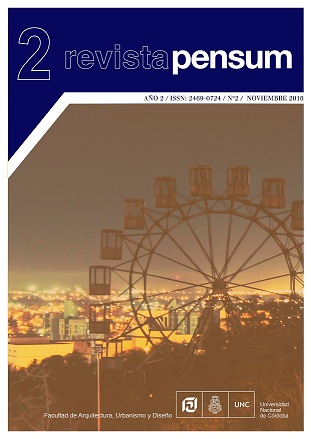GEOMETRIES AND ARCHITECTURAL FORM IN CONTEMPORARY LOGICS’ PROJECT. APPROXIMATION TO NEW ORDERS UNDER THE PARADIGM OF THE COMPLEXITY
DOI:
https://doi.org/10.59047/2469.0724.v2.n2.16518Keywords:
Geometry - Architectural form - ParadigmsAbstract
The topic registers in the area of convergence of knowledge historically tied: geometry and architecture. The geometry, as axiomatic system, contributes to the knowledge of the reality providing a formal skeleton adapted to describe it, to understand and to control it. It provides with form and order to the architecture. The relations between geometry and architecture keeps a vision of the world typical of certain time and space. To investigate in the usage of Cartesian or complex geometries in the project allows new approximations of the architecture inside a complexity assumed as the starting point and in to the recovery of the epistemological basis of the project. The principal question of this work is: how to rethink the role of the geometries in relation to certain logics’ project in the context of the new contemporary paradigm?References
Araujo Armero, Ramón (2004). Geometría, técnica y arquitectura. Tectónica: monografías de arquitectura,
tecnología y construcción n0 17 (Barcelona).
Cohen, Alejandro (2014). Módulo: Taller de Proyecto. Doctorado en Arquitectura. Escuela de Graduados. Facultad
de Arquitectura, Urbanismo y Diseño. Universidad Nacional de Córdoba. Córdoba.
Fernández, Roberto (2007). Lógicas del proyecto. (Buenos Aires: UniGraf).
Fernández, Roberto (2011). Mundo diseñado. Para una teoría crítica del proyecto total. (Santa Fe: ediciones UNL).
Fernández, Roberto (2012). La investigación en programas de Doctorado en Arquitectura [en línea][citado 7 de mayo de 2014]. Disponible en internet en: http://dl.dropbox.com/u/24631442/DOCTORADO/R_Fernandez_
LaInvestigacionenProgramasdeDoctoradoenArquitectura.pdf
Fernández, Roberto (2014). Módulo: Teorías, críticas y gestión de la arquitectura, la ciudad y el territorio. Doctorado en Arquitectura. Escuela de Graduados. Facultad de Arquitectura, Urbanismo y Diseño. Universidad Nacional de Córdoba. Córdoba.
Fraenza, Fernando (2013). Módulo: Antropología cultural. Doctorado en Arquitectura. Escuela de Graduados.
Facultad de Arquitectura, Urbanismo y Diseño de la Universidad Nacional de Córdoba. Córdoba.
García Fanlo , Luis (2011). ¿Qué es un dispositivo? A Parte Rei: revista de filosofía no. 74 [en línea] [citado 25 de octubre de 2013]. Disponible en internet en: http://serbal.pntic.mec.es/~cmunoz11/fanlo74.pdf
Gausa, Manuel (1999). Tiempo dinámico-orden ?in> formal: trayectorias ?in> disciplinadas. Quaderns d’arquitecture I urbanisme n? 222. (Barcelona).
Klimovsky, Gregorio (1997) Las desventuras del conocimiento científico. Una introducción a la epistemología. 3ra. edición. (Buenos Aires: AZ).
Moisset de Espanés, Inés (2003). Fractales y formas arquitectónicas. (Córdoba: i+p).
Montaner, Josep Maria (2002). Las formas del siglo XX. (Barcelona: Gustavo Gili).
Montaner, Josep Maria (2013) Arquitectura y crítica. 3ra. edición. (Barcelona: Gustavo Gili).
Morin, Edgar (2007). Introducción al pensamiento complejo. 9na. Edición. (Barcelona: Gedisa).
Prigogine, Ilya (1998). El fin de las certidumbres. 6ta edición (Santiago de Chile: Andrés Bello)
Sarquis, Jorge (2013). Módulo: Metodología de la Investigación en Arquitectura. Doctorado en Arquitectura. Escuela de Graduados. Facultad de Arquitectura, Urbanismo y Diseño. Universidad Nacional de Córdoba. Córdoba.
Downloads
Published
Issue
Section
License
Authors who publish in this journal agree to the following terms:
a. Authors retain copyright and guarantee to the journal the right to be the first publication of the work as well as licensed under a Creative Commons Attribution-ShareAlike 4 license.
b. Authors may separately establish additional agreements for non-exclusive distribution of the version of the work published in the journal (e.g., placing it in an institutional repository or publishing it in a book), with an acknowledgement of its initial publication in this journal.
c. Authors are permitted and encouraged to disseminate their work electronically (e.g., in institutional repositories or on their own website) before and during the submission process, as this may result in productive exchanges, as well as earlier and greater citation of published work (See The Effect of Open Access).
d. 4.0 International Creative Commons Attribution-ShareAlike 4.0 License.












